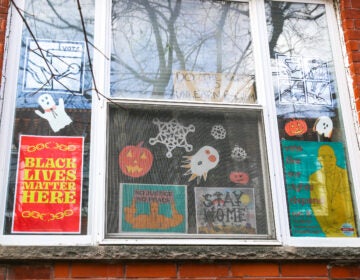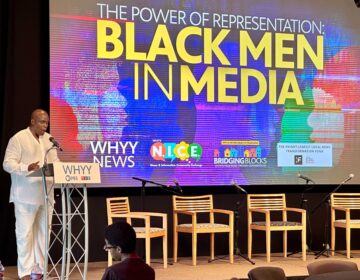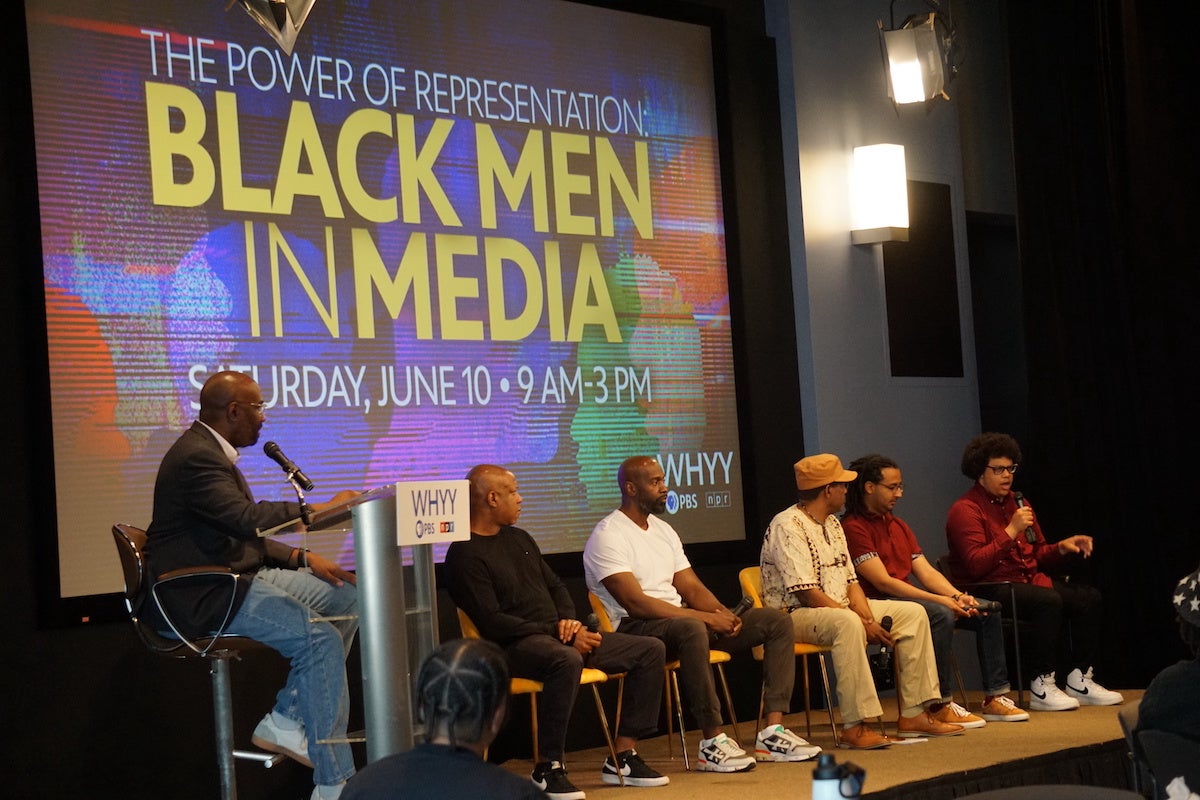Penn’s first Black newspaper EIC on racism in media
The Daily Pennsylvanian’s first Black editor-in-chief offers a look at how journalists of color are fighting racism in media and reshaping the industry.
Listen 4:06
Protesters march from the scene of Walter Wallace Jr.’s killing to Malcolm X Park. (Emma Lee/WHYY)
Last November, I became The Daily Pennsylvanian’s first Black editor-in-chief — an accomplishment that to this day has not fully sunk in, even as I begin my last semester on the job. Yet mixed with the pride and excitement I feel as the head of such a historic organization is fear and pressure. Fear that I’m not good enough, and pressure to prove to everyone, including myself, why I belong.
When we’re young, we’re encouraged to be first. The first to get in line at the water fountain after recess. The first to finish an assignment (accurately). The first to finish conditioning at sports practice. But in a world full of firsts, what if I’m the last? What if I’m not able to effect the change I want to make?
For three years, as a columnist and reporter, I’ve simultaneously been forced to play the role of the voice of the Black community in the newsroom, and the newspaper’s loyal promoter, even if it made mistakes that harmed my own community. And for three years, I have had a difficult time bridging those two identities — and communities — together.
This appears to be the case everywhere. Communities of color and the media have long had a tenuous and exploitative relationship, with journalists reporting about communities of color primarily when something bad has happened, and rarely to highlight development, innovation, or other achievements.
From the disproportionate effect of COVID-19 on communities of color, to widespread instances of police brutality against Black and Brown communities, the events of this past year have led to a nationwide racial reckoning, in which institutions such as corporations, governments, and universities have been forced to contend with their respective structures and ideologies.
Yet an onslaught of testimony from journalists of color around the country that they are not supported in their newsrooms has forced the media industry to examine its legacy of racism, and how this history has manifested in today’s newsrooms, which lack Black staff and which insufficiently cover Black communities — despite many newsrooms existing in, and therefore covering, regions that are majority-Black.
This fight for equity has been a long time coming, media experts and journalists of color tell me, and will continue well into the future, if industry leaders neglect to listen to the needs of both their journalists of color and the surrounding community the journalists cover, and fail to prioritize in-depth reporting on race and its intersections with society. This is particularly relevant when it comes to local media that, like PlanPhilly, cover the systems that determine people’s access to housing, education, opportunity and the environmental resources they need to thrive.
“What is important in what you’re seeing is more journalists, particularly journalists who come from marginalized groups, really pushing back against this idea that we’ve ever experienced objectivity,” Nikole Hannah-Jones, a Pulitzer Prize-winning investigative reporter and the Knight Chair in Race and Journalism at Howard University, said. “Instead, what we’re calling for is an acknowledgment that everyone is reporting out of some type of bias, and that it’s only in being honest about what that bias is or what the biases are that we can actually have the best reporting.”
‘People’s lives are at stake’
Running slave ads. Helping lead coups to overthrow Wilmington, North Carolina’s multiracial government. Arresting a Black editor for publishing stories praising the bravery of Black soldiers and charging him with espionage. Launching television programs that block integration efforts. These are just a few snapshots of American media’s history, as documented by Free Press in their 2020 report, “Media 2070: An Invitation to Dream Up Media Reparations.”
The essay, which traces the industry’s legacy of profiting from slavery, calls for policies that force organizations to be held accountable for their role in endorsing and perpetuating racial oppression. It demands contemporary media institutions make amends to the communities they’ve harmed.
“The white-dominant press has used the power of racist narratives to subjugate, punish, and control Black bodies and perpetuate white supremacy — both intentionally and unintentionally. Controlling narrative is about maintaining power,” the essay reads. “And that power has been wielded against Black and other Indigenous and colonized people to launch disinformation media campaigns from colonial times to the present.”
That history, along with the disconnect between the media representation of Black America and the reality, motivated Hannah-Jones to be a journalist. She first reported on race as a high school student, as part of a school desegregation program. But her awakening to the racist practices still powering the industry came early in her career when she went on to work at The Oregonian and ran into a problem she said many journalists of color face: She was told she could not report on race because it would be perceived as biased reporting.
“I was being penalized and called into editorial meetings because they saw my desire to write about people of color as a bias, and I saw it as the reason why I became a journalist,” she said. “Of course, you don’t see white journalists being called into editorial meetings because they’re writing about white people too much.”
The experience almost drove Hannah-Jones out of journalism.
“To be told that my wanting to write about racial inequality was a problem, that The Oregonian’s white readership wasn’t really interested in those stories, I didn’t see a purpose in being a journalist if I couldn’t do the stories that I got into journalism to do,” she said.
How could such a thing happen decades after mainstream American media declared itself integrated and part of the solution? Experts point to a number of problems that are structural, systemic and highly personal, too. They cited a lack of partnerships with affinity organizations such as the National Association of Black Journalists, the National Association of Hispanic Journalists, and the Asian American Journalists Association; an insufficient number of staff and editors of color; inadequate training on how to properly engage with communities of color; and failure to acknowledge mistakes and harms caused to the local community.
“I understand the news cycle, I understand the crunching of the deadline, but people’s lives are at stake here, and people’s humanity is on the line every time we report on something,” Tauhid Chappell, one of the contributors to the Media 2070 project, said.
A walkout that led to action
A June 2020 Philadelphia Inquirer headline read “Buildings Matter, Too.” It was labeled an editorial mistake by leadership, for which the newspaper publicly apologized. But the newspaper’s journalists of color were ready to act, tired of seeing “trust eroded in an instant by careless, unempathetic decisions,” as they stated in a public letter published online before dozens walked out and a top editor was forced to resign.
Following the public outcry, Andrea Wenzel, an assistant professor in Temple University’s Department of Journalism, and a team of researchers from the University, published an audit of the paper, which found it to have an “overwhelmingly white” newsroom that struggles to retain journalists of color, leading to the production of content that overrepresents white males.
Wenzel specializes in the relationship between local journalism and communities, studying how sourcing, editing practices, and workplace culture can affect people and their trust of the media. A series of focus groups she conducted with Philadelphia residents pointed to deep levels of distrust and much frustration over how the city’s Black and brown communities are depicted.
“There’s a sense that journalists only came in to cover a fire, or crime, or a negative story, and that eroded any sort of sense of trust and damaged the relationship,” she said. “People have often shared that even stories that weren’t necessarily terrible, but were stories that were being told about their community, were about them but not for them.”
This distinction, Wenzel explained, is crucial.
“Even reporters who have the best of intentions, who are trying to do good stories, and who are trying to cover communities of color and trying to cover them well, if they’re being edited in such a way where there’s an assumption that the audience is white, and the story has to be explained for a white audience, then the story is going to end up not feeling like it’s for the community of color that the story is about,” Wenzel said.
One positive outcome of the audit, she said, was forcing media leadership to involve themselves in the work of cultural change.
“The burden of fixing the problem shouldn’t be on journalists of color at all. It’s the problem of white journalists and white editors that they need to take ownership of,” she said.
But for Ernest Owens, president of the Philadelphia Association of Black Journalists, the problem won’t be fixed if media institutions don’t partner with affinity organizations that hold the expertise often lacking within white-led structures. He outlined a cycle in which organizations would present diversity, equity, and inclusion plans without first consulting with groups like PABJ, calling the gesture “insulting” and “infuriating.”
“It was like they were pitching something to us, and just wanted us to give them a thumbs up, rather than actually having us be part of the initial stages and processes,” he said. “I think we’re at a point where we do not trust media institutions to do diversity, equity, and inclusion internally; they have to work with the community, they have to work with outside organizations that are leading the charge — organizations like mine and other groups.”
While Owens said The Philadelphia Inquirer had fallen victim to this tactic before, recent meetings with leadership left him feeling optimistic. The two organizations worked out a partnership in March that includes, among other DEI initiatives, a new apprenticeship for “early-career” Black and brown journalists and a new Community Advisory Council.
Similarly, a 2018 audit Wenzel conducted of WHYY prompted the newsroom to embrace widespread recruitment of staff of color through a pipeline that includes collaboration with NABJ and National Public Radio training programs for non-white journalists, Vice President for News and Civic Dialogue Sandra Clark said. From May 2018 to April 2021, the percentage of staff of color increased by 18%, according to the audit.
The WHYY newsroom has also mandated that all reporters track their sources — a change that has resulted in more diverse voices on air and online, according to WHYY data. The percentage of sources of color increased by 19% in 2020. In addition, the organization last year launched its first bilingual reporting project, “Route 47: Historias along a bus route,” and a mutual-aid inspired News & Information Community Exchange. The latter operates as a partnership between grassroots news and information content creators, many of whom are people of color who are already serving their communities.
The community-based creators are compensated and given resources to grow in an intentional effort to support their operations outside of the mainstream media bubble, a break from older paradigms that purported to pay contributors in prestige, without acknowledging the professional quality of their work.
It is partnerships like these that experts say are the first step to moving beyond an individualized, and to a systemic, method of achieving antiracist journalism.
‘Inclusion isn’t enough’
At the Maynard Institute for Journalism Education, a 40-year-old American nonprofit organization that trains people of color to become journalists and aims to increase their representation in the media industry, the organization’s mission statement is no longer just about achieving diversity and inclusion, but about dismantling systemic racism and creating institutions of belonging, co-executive director Martin Reynolds told me. In October 2020, the Maynard Institute in conjunction with the Online News Association and OpenNews announced Vision25: Building Racial Equity in Newsrooms, an effort to build newsrooms that are actively anti-racist.
“Inclusion to us isn’t enough. Inclusion is like tolerance; you tolerate your in-laws when they come over the holidays, or you tolerate an annoying friend,” he explained. “Whereas when you belong somewhere, you can feel it in your bones, you can feel it in the language you can use, in the stories you’re doing, you can feel it in the equitable pay you receive, you can feel it in the culture of the organization, and so what we are excited about is creating a pathway to belonging that news organizations can then follow.”
Both WHYY and the Inquirer have done Maynard Institute training, and after the Inquirer audit, the newspaper’s leadership has committed to doing further work with Maynard.
“From a content standpoint, from a culture standpoint, from an audience engagement standpoint, if we’re not really able to create an institution that truly represents the voices of our community, we won’t survive as an organization,” said Jameel Rush, the Inquirer’s vice president of Diversity, Equity, and Inclusion, who was hired in the wake of the audit. “It’s critical to the success of our organization, and that pushes results like none other, not to mention it’s just the right thing to do.”
The primary audit recommendations entail inclusive sourcing practices, such as tracking for diversity; inclusive editing practices, which involves producing and editing coverage that is for communities of color, as opposed to just about them; community engagement and accountability; and workplace equity/culture, which comprises restructuring hiring, payment, and retention systems.
All of that reflects a similar call to action for public media organizations across the country, in which more than 200 public radio leaders signed onto a document titled “An antiracist future: a vision and plan for the transformation of public media.”
After more than 200 people tried to attend the first Zoom call, Celeste Headlee, one of the movement’s leaders, recalled, “it became clear that if we worked together, we could get a lot more accomplished than what we’ve been doing before, which was working individually.”
‘A different time period’
In Chappell’s eyes, the racist headlines and workplace microaggressions have always existed. What’s different now is a political climate that has made society more receptive to journalists’ fight for racial equity.
“We’re in a different state of society where we have more access to, and democratization of, social media, where people can talk their truth, share their narratives, and disrupt and distort the media narratives that are often perpetuated,” he said. “And I think that we’re also in a different time period coming off of Trump, where there’s a lot more tension in the air; there’s a lot more noticeable, shareable, transfixing, acceptable information that is galvanizing people to respond and empowering people to call things out for what they are.”
For media leaders who are approached by journalists of color with calls for action, the notion should be seen as positive and shouldn’t put managers on the defensive, Headlee said.
“Criticism is healthy, and when the employees at a station or in any workplace are coming to management with critiques, with feedback, they wouldn’t do that if they didn’t care,” she advised. “It’s scary to criticize your own managers. It’s scary to approach your executives with demands. And the only thing that’s motivating them is this optimism that things can be better.”
Hannah-Jones added that the recruitment of journalists of color is one thing, but retention is another, noting that data from a recent New York Times diversity and inclusion report suggested that while there was an increase in hires, institutions are losing as many journalists as they are bringing in.
“You have to actually be able to support and respect those journalists and not expect us to come in and conform to institutions, but actually build institutions that are reflective of all of us,” she said. “Most newsrooms want phenotype diversity, but they don’t actually want diversity of thought and experience, so they want to hire someone who looks Black, but then they don’t want you to report from a Black perspective.”
As for advice for my generation, it’s always about accuracy, Hannah-Jones told me.
“We treat people with power very differently than we treat people who we don’t think have power; we don’t give the same deference, we don’t ensure the accuracy by reading back quotes, and I think we have to change those dynamics,” she said. “Why does it matter? Because we are portraying in the pages of newspapers and on TV and on radio an America that doesn’t actually exist.”

Subscribe to PlanPhilly
WHYY is your source for fact-based, in-depth journalism and information. As a nonprofit organization, we rely on financial support from readers like you. Please give today.







